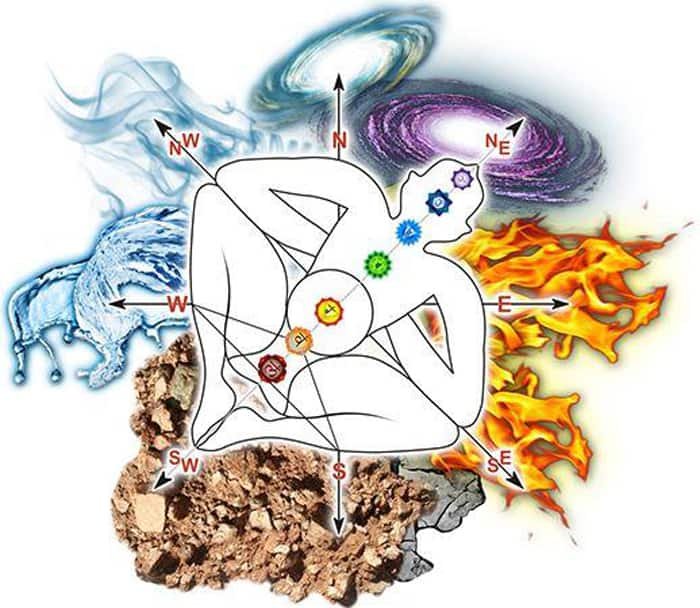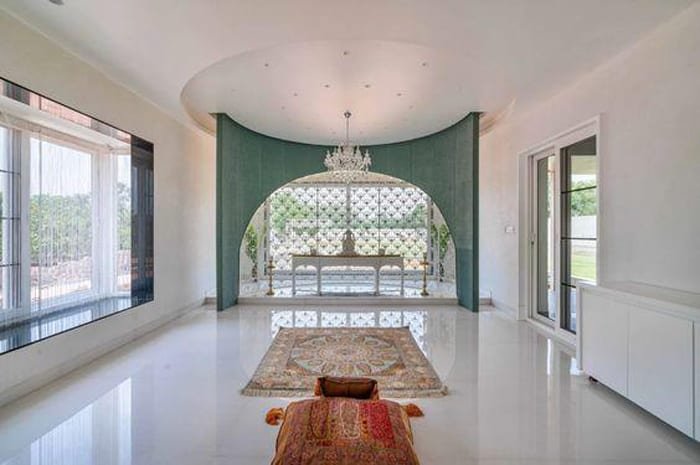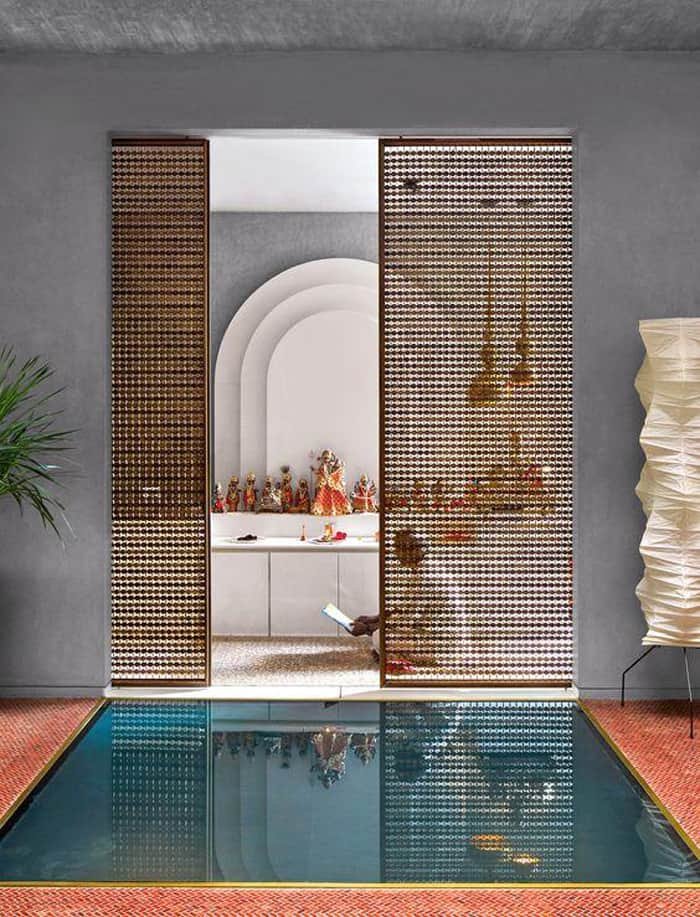Pooja room Vastu is an ancient Hindu science that helps to create a peaceful and positive space for prayer and meditation in an Indian home. Although the specifics of Vastu can vary depending on region and personal preference, some general principles are followed to create a harmonious space. This post explores the ideal layout for a pooja room according to Vastu principles. By following these DIY pooja room vastu tips, you can create a space that is both peaceful and positive, perfect for your daily worship.
Table of Contents
Seven Simple Pooja Room Vastu Tips
- North-east direct
- Well lit with natural light
- Proper seating
- Shrine or altar for worship
- Pictures and idols of the deities
- Lamp/incense burner and gong
- Plants to symbolise growth
What Is Vastu?

Vastu is a traditional Indian system of architecture and construction that is based on the laws of nature. The word “Vastu” means “house” in Sanskrit, and the system is designed to ensure that a dwelling is in harmony with the natural world. The principles of Vastu are said to bring health, wealth, and happiness to those who live in houses designed and built according to them.
Vastu has its roots in the Vedas, the oldest sacred text of Hinduism. The system was developed over time and has been documented in several ancient texts. In recent years, Vastu has gained popularity in the West, and there are now many books and websites dedicated to the subject.
How does Vastu Work?

There is a lot of debate surrounding the science of Vastu shastra. Some people believe it is pseudoscience, while others believe it has a valid scientific basis. The truth is, there is no concrete evidence to support either claim. However, there are a few theories that suggest how Vastu might work.
One theory is that balancing the five elements creates a harmonious environment that is conducive to peace and positive energy.
Another theory is that Vastu works subconsciously and that the positive affirmations often used in Vastu can influence our thoughts and emotions. Whether Vastu works is still up for debate.
However, there is no harm in following the principles of Vastu, as it can create a sense of peace and calm in your home.
Benefits Of Incorporating Vastu Tips In Your Space
When decorating your home, you want it to reflect your style. But you also want it to be where you feel comfortable and at peace. That’s where incorporating Vastu into your décor comes in.
You can create a sense of peace and well-being by incorporating Vastu into your space. There are several benefits to incorporating Vastu into your home décor.
Here are just a few:
1. Vastu can improve your health.

One of the main benefits of incorporating Vastu into your home décor is that it can help to improve your health. Vastu focuses on placing objects and buildings to create a sense of harmony and balance. You can create a sense of peace and well-being by incorporating Vastu into your space. This can help to reduce stress levels and promote relaxation.
2. Vastu can help to improve your relationships.

Another benefit of incorporating Vastu into your home décor is that it can help to improve your relationships. When you create a space that is peaceful and harmonious, it can help to reduce arguments and conflicts. Additionally, it can also help to promote communication and understanding. Creating a space conducive to peace and harmony can help improve all of your relationships, whether with your family, friends, or co-workers.
3. Vastu can help to improve your finances.

Yet another benefit of incorporating Vastu into your home décor is that it can help to improve your finances. As stated above when you create a space that is peaceful and harmonious, it can help to attract positive energy. This positive energy can then help to improve your financial situation.
Similarly, Vastu can also help to improve your career. A peaceful and harmonious home can help to create a positive work-life balance. This can lead to improved job satisfaction and increased productivity. Additionally, Vastu can help improve your work performance by reducing stress levels.
4. Vastu can help to improve your overall sense of well-being

Finally, incorporating Vastu into your home décor can also help to improve your overall sense of well-being. When you create a space filled with positive energy, it can help to reduce stress levels and promote relaxation. Additionally, Vastu can also help to improve your sleep quality. Furthermore, by improving your finances and career, Vastu can also help to improve your overall sense of well-being.
So, if you’re looking for a way to create a more peaceful and harmonious home, Vastu is a great option.
Pooja Room Vastu Tips for Your Indian Home (With Explanation)
When it comes to your Indian pooja room, there are a few key things to keep in mind to create a space that is not only aesthetically pleasing but also Large; colorful paintings or tapestries of religious figures are often used to add color and life to the room, while a statue or shrine of the deity you worship can be a focal point.
However, it is also important to consider the direction of your pooja room to create a space that aligns with Vastu principles. Here are a few pooja room vastu tips to keep in mind:
1. The Pooja room should be in the home’s north, east, or northeast direction.

This one is the most important of pooja room vastu tips. The north, east, and northeast directions are said to be ruled by the Agni (fire) element. The fire element is said to be the purest and most powerful of all the elements. It is associated with knowledge, wisdom, and creativity.
Fire is also said to be the destroyer of all evils. Therefore, having a Pooja room in these directions is encouraging and beneficial. The north, east, and northeast directions are also said to be the directions of the gods.
2. The Pooja room should be well-lit with natural light.

Many Vastu shastras dictate the placement of certain objects and furniture in a room. However, one of the most important things to consider, according to Vastu, is the lighting of a room. The Indian pooja room, in particular, should be well-lit with natural light.
There are several reasons why natural light is so important in a pooja room.
- Firstly, it creates a positive and uplifting environment.
- Secondly, it brings positive energy into the room and helps to purify the air.
- Thirdly, it helps to focus the mind and creates a feeling of peace and tranquility.
So, if you want to create a positive and peaceful environment in your home, follow the Vastu guidelines and allow natural light to enter your pooja room.
3. The room should have a comfortable seating area for prayer and meditation.

There are many reasons why the pooja room should have a comfortable seating area for prayer and meditation.
- First and foremost, it is a place where we connect with the Divine. It is where we can be still and connect with our higher selves. To have a comfortable and authentic connection with the Divine, it is important to have a comfortable and relaxed setting.
- Secondly, the pooja room is a place of peace and calm. It is where we can go to escape the hustle and bustle of everyday life. When comfortable and calming elements surround us, it allows us to fully relax and let go of all our worries and stress.
- Lastly, the pooja room is a place of healing. When we are in a state of prayer and meditation, we open ourselves up to receive guidance and healing from the Divine. When comfortable and peaceful elements surround us, it provides us with the perfect environment to allow for this healing to take place.
4. The room should have a shrine or altar for worship.

There are many schools of thought when it comes to the decoration of shrines and altars for worship. Some people believe it is important to follow the guidelines of the Vastu shastra, while others believe it is more important to go with what feels right for them. Ultimately, the decision is up to the individual worshiper.
However, a few general tips can be followed when decorating a shrine or altar for worship according to the Vastu shastra.
- The shrine or altar should be placed in the northeast corner of the pooja room. This is the direction that is considered to be most auspicious for worship.
- The shrine or altar should be made of natural wood, stone, or clay. The shrine or altar should be placed at a level that is higher than the level of the rest of the room. This helps to create a sense of reverence and respect for the object of worship.
- The shrine or altar should be kept clean and free of clutter. This helps to create a sense of peace and serenity.
5. The room should have pictures or statues of a deity.

One of the most important things to consider when setting up a pooja room is the decoration of the room itself. According to Vastu, there are certain ways that the picture or statue of a deity should be decorated to create a sacred and holy space. Here are a few tips to keep in mind:
- The picture or statue of the deity should be placed on a high platform. This represents the lofty status of the deity and helps to create a sense of reverence.
- The deity should be facing east, which is the direction of the rising sun. This represents the deity’s connection to the energy of the sun and the cosmos.
- Fresh flowers and lights should surround the picture or statue. This represents the purity and radiance of the deity.
- The pooja room should be kept clean and free from clutter. This represents the cleanliness and sanctity of the space.
- The pooja room should have a sacred text such as the Bhagavad Gita or the Bible.
6. The pooja room should have an incense burner or lamp and a bell or gong.

According to Vastu, these objects purify the air and create a sacred space. They also represent the five elements: fire, earth, water, air, and space.
- The incense burner or lamp represents fire. Fire is the element of transformation. It is associated with the energy of the sun and the planet Mars. The incense burner or lamp purifies the air and dispels negative energy.
- The bell or gong represents earth. Earth is the element of stability. It is associated with the energy of the moon and the planet Venus. The bell or gong grounding energy helps to create a sense of calm.
- The pooja room should also have a water element. This can be in the form of a statue or a river or a waterfall painting. Water is the element of emotion. It is associated with the energy of the planet Mercury.
- The water element purifies the mind and body and helps to open the heart chakra. The air element can be represented by a hanging wind chime or a fan. Air is the element of communication.
These objects in the pooja room create a space conducive to meditation and prayer. They help to focus the mind and connect us to the Divine.
7. The pooja room should have a plant or flower to symbolize growth and life.

One of the most important things to consider when decorating a pooja room in India is what kind of plant or flower symbolizes growth and life. According to Vastu, certain plants and flowers are more auspicious than others. Here are some of the most popular choices:
- Lotus: The lotus symbolizes purity, spiritual awakening, and rebirth. It is also said to represent the true self, free from the material world’s turmoil.
- Tulsi: Tulsi, also known as holy basil, is a sacred plant in Hinduism. It is often planted in front of temples and homes as a sign of reverence. Tulsi is said to represent piety, chastity, and goodness.
- Hibiscus: Hibiscus is a symbol of purity and innocence. In Hinduism, it is often associated with the goddess Lakshmi.
- Rose: The rose symbolizes love, appreciation, and respect. In Hinduism, it is often given as a sign of gratitude.
- Sunflower: The sunflower is a symbol of worship and adoration. In Hinduism, it is associated with the sun god, Surya.
Conclusion
If you follow these pooja room vastu tips when designing your puja room, you can be sure that you will create a beautiful and spiritually uplifting space. You can create a truly special and sacred space by choosing the right colors, materials, and layout for your pooja room. Take some time to consider how you want your pooja room to look and feel, and then use these tips to make it happen. Your family and friends will be amazed at the transformation!
If you have some great Vastu tips, feel free to drop some in the comments.
Frequently Asked Questions
Vastu Shastra is complicated and complex. We understand that it can be difficult to grasp all these tips fully. Hence, we have compiled a bunch of FAQs to make understanding the science of pooja room vastu tips easier.
What are the basic principles of designing a Pooja room according to Vastu?
There are several principles to keep in mind while designing a Pooja room per Vastu. The room should be preferably located in the northeast corner of the house, as this is considered the most auspicious direction. It should be well-lit and airy, and the idol should be placed on a raised platform.
What are the benefits of having a Pooja room?
There are many benefits of having a dedicated Pooja room in the house. It helps create a sacred and calm space for daily worship and contemplation. It also fosters a sense of peace and positive energy in the home.
What should be kept in mind while selecting the location for the Pooja room?
The most important factor to consider while selecting the location for the Pooja room is the direction. The room should be located in the northeast corner of the house, as this is considered the most auspicious direction. Another important factor to consider is the lighting and ventilation of the room.
What are the dos and don’ts of designing a Pooja room?
There are several dos and don’ts to remember while designing a Pooja room. Locating the room in the northeast corner of the house is important, as this is considered the most promising direction. The room should be well-lit and airy, and the idol should be placed on a raised platform. Other important things to keep in mind are to use bright and light colors for the walls and to avoid clutter in the room.
How can I ensure that the Pooja room complies with Vastu tips?
The best way to ensure that the Pooja room complies with Vastu is to consult a Vastu expert. They will be able to give you specific guidance on how to design the room per the principles of Vastu. Or you can place your query in the comments, and we will reach out to you.
What are some common mistakes made while designing a Pooja room?
Some common mistakes made while designing a Pooja room include:
● Locating the room in the wrong direction.
● Not providing adequate lighting and ventilation.
● Placed the idol on the floor instead of on a raised platform.





